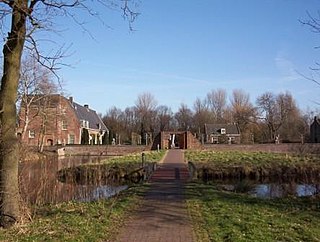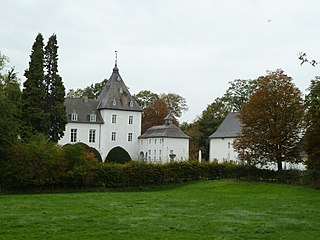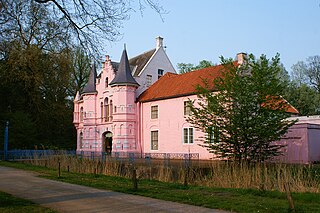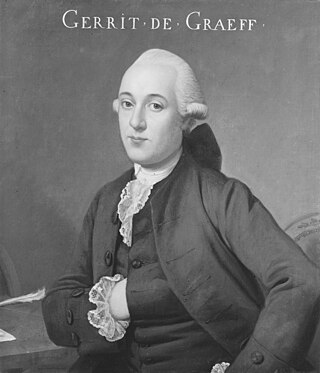
Haarlem is a city and municipality in the Netherlands. It is the capital of the province of North Holland. Haarlem is situated at the northern edge of the Randstad, one of the more populated metropolitan areas in Europe; it is also part of the Amsterdam metropolitan area. Haarlem had a population of 162,543 in 2021.

Heemstede is a town and a municipality in the Western Netherlands, in the province of North Holland. In 2021, it had a population of 27,545. Located just south of the city of Haarlem on the border with South Holland, it is one of the richest municipalities of the Netherlands.

The Spaarne is a river in North Holland, Netherlands. This partially canalized river connects the Ringvaart to a side branch of the North Sea Canal. It runs through Haarlem, Heemstede, and Spaarndam.

Spaubeek is a village in the Dutch province of Limburg. It is located in the municipality of Beek, about 3 km south of the town of Geleen. Spaubeek was a separate municipality until 1982, when it was merged with Beek.

Horn is a village in the Dutch province of Limburg. It is a part of the municipality of Leudal, and lies about 5 km northwest of Roermond.

Heemstede Castle is the site of the old castle of Heemstede. The property is situated at the site of the former castle 'Heerlijkheid Heemstede', or 'Huis te Heemstede', at a strategic position on mouth of the Spaarne river on the Haarlem lake.

The Leidsevaart is a canal between the cities of Haarlem and Leiden in the Netherlands. It was dug in 1657, making it one of the oldest canals in the Netherlands. It was the major means of transport between Leiden and Haarlem for almost two centuries until the rail connection was established in the 19th century. The original stops along the railway mirrored the toll bridges of the canal.

Rijckholt is a village in the Dutch province of Limburg. It is located in the municipality of Eijsden-Margraten.

Nieuwkuijk is a village in the Dutch province of North Brabant. It is located in the municipality of Heusden, about 10 km west of 's-Hertogenbosch.

John Hope, also known as Jan Hope, was a wealthy Dutch banker, participating in Hope & Co., a member of the city council and an art collector. In 1770 he was appointed as manager of the Dutch East India Company (VOC). He is also known today for his Groenendaal Park in Heemstede, where he summered on his estate. Shortly before he died he bought the nearby "Bosbeek". This estate became one of the first examples of a large garden in the 'English Style' in the Netherlands, and shaped by his second son Adrian Elias. His oldest son Thomas Hope became a designer of neoclassical interior decoration, and his youngest son Henry Philip Hope a gem collector and jewelry specialist.

Mattheus Lestevenon, heer van Berckenrode was a city-secretary and schepen in Amsterdam, then Dutch ambassador to France. Lestevenon played an important role in the year 1748 and in the negotiations for the Treaty of Paris. Pietro Locatelli dedicated six violin sonatas to him.

A heerlijkheid was a landed estate that served as the lowest administrative and judicial unit in rural areas in the Dutch-speaking Low Countries before 1800. It originated as a unit of lordship under the feudal system during the Middle Ages. The English equivalents are manor, seigniory and lordship. The German equivalent is Herrschaft. The heerlijkheid system was the Dutch version of manorialism that prevailed in the Low Countries and was the precursor to the modern municipality system in the Netherlands and Flemish Belgium.

Johan de Graeff, also Jan de Graeff - patrician of Amsterdam, Free Lord of Zuid-Polsbroek - was a member of the De Graeff - family from the Dutch Golden Age. His political Position was that of the Dutch States Party.

Gerrit de Graeff belonged to the patrician class of Amsterdam and held the feudal titles Free Lord of Zuid-Polsbroek as those of 21st Purmerland and Ilpendam. Known for his wealth and notorious for his stinginess, De Graeff was not particularly popular.

Cornelis de Graeff was a member of the family De Graeff, a prominent regent family from the Dutch Golden Age. He held the title 20th Free Lord of Purmerland and Ilpendam.

The Free or high Lordship of Purmerend and Purmerland and after 1618 Purmerland and Ilpendam was a type of local jurisdiction with many rights.

Brederode Castle, also called the Ruins of Brederode, is located near Santpoort-Zuid. The castle was founded in the second half of the 13th century by William I van Brederode (1215–1285). William was a descendant of the lords van Teylingen, who were related to the counts of Holland. The castle formed part of the high lordship Brederode, which had been given in loan in the 13th century to the lords of Brederode by the count of Holland.

Iepenrode, or Ipenrode, is the name of a villa in Heemstede, the Netherlands, between the Leidsevaart and Herenweg, located north of Huis te Manpad and south of Berkenrode. It was once the summer home of various mayors (burgemeesters) of Haarlem and is currently privately owned.

Daniël Raap was a porcelain merchant who played a leading role during the Orangist revolution in the Netherlands of 1747–1751.

Haerlempjes refer to a specific genre of landscape painting that includes a view of Haarlem. It is used most often to refer to Jacob van Ruisdael's panoramic views of the city, but the term is derived from mentions in Haarlem archives as a type of painting included in household inventories. The diminutive suffix "pje" would denote a small, cabinet-sized painting, but even the largest landscapes may be referred to as Haerlempjes today.

























